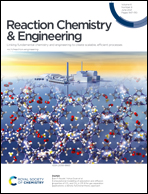Roles of ethanol and Si–OH in the aldol condensation of ethyl acetate over a Cs/SBA-15 catalyst†
Abstract
Alkali and alkaline earth metal-supported mesoporous SBA-15 catalysts via impregnation were characterized and tested in the vapor phase aldol condensation of ethyl acetate and formaldehyde in ethanol to synthesize ethyl acrylate (EA) and acrylic acid (AA). Ethanol dehydrogenation exerts a negative effect on the main reaction, and Lewis acid sites donated by either gust or support prefer forming acetaldehyde to compete for formaldehyde with the main aldol condensation. Combined with the good dispersion of active sites and acceptable diffusion conditions, the pairs of weak acidity and weak-medium basicity enable 5Cs/SBA-15 to achieve the highest yield of 63% for acrylic products based on formaldehyde. Aliphatics are confirmed as the main compositions of coke depositions to lead the deactivation of cesium-modified catalysts whose activity could be regenerated completely by calcination. According to experimental and DFT results, Si–OH assisting Si–O–Cs plays the role of accelerating the enol structure formation by decreasing the activation barrier, and performs the necessary favor for the cleavage of ethanol hydroxyl by reducing the electronegativity of ethanol oxygen. The predominant pathway for producing AA is also confirmed through EA hydrolysis, and the relatively strong adsorption energy of EA should account for the high AA/EA molar ratio.



 Please wait while we load your content...
Please wait while we load your content...